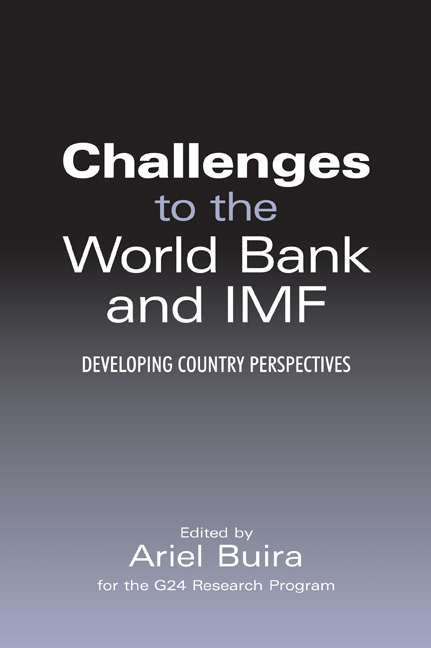Book contents
- Frontmatter
- Contents
- Contributors to this volume
- Foreword
- Introduction
- 1 The Governance of the IMF in a Global Economy
- 2 Who pays for the IMF?
- 3 An Analysis of IMF Conditionality
- 4 Achieving Long-Term Debt Sustainability in Heavily Indebted Poor Countries (HIPCs)
- 5 The Poverty Reduction Strategy Paper Approach: Good Marketing or Good Policy?
- 6 Capital Management Techniques in Developing Countries
- 7 International Reserves to Short-Term External Debt as an Indicator of External Vulnerability: The Experience of Mexico and Other Emerging Economies
- 8 Mechanisms for Dialogue and Debt-Crisis Workout that Can Strengthen Sovereign Lending to Developing Countries
- 9 Developing a Global Partnership for Development
- 10 International Financial Institutions and International Public Goods: Operational Implications for the World Bank
- Index
1 - The Governance of the IMF in a Global Economy
Published online by Cambridge University Press: 10 September 2020
- Frontmatter
- Contents
- Contributors to this volume
- Foreword
- Introduction
- 1 The Governance of the IMF in a Global Economy
- 2 Who pays for the IMF?
- 3 An Analysis of IMF Conditionality
- 4 Achieving Long-Term Debt Sustainability in Heavily Indebted Poor Countries (HIPCs)
- 5 The Poverty Reduction Strategy Paper Approach: Good Marketing or Good Policy?
- 6 Capital Management Techniques in Developing Countries
- 7 International Reserves to Short-Term External Debt as an Indicator of External Vulnerability: The Experience of Mexico and Other Emerging Economies
- 8 Mechanisms for Dialogue and Debt-Crisis Workout that Can Strengthen Sovereign Lending to Developing Countries
- 9 Developing a Global Partnership for Development
- 10 International Financial Institutions and International Public Goods: Operational Implications for the World Bank
- Index
Summary
Abstract
The chapter reviews the elements that constitute the power structure (basic votes, quotas and the qualified majorities) by which the IMF is governed, following the commitment made by all participants in the Monterrey Consensus to increase the voice and participation of the developing countries and transition economies in the Bretton Woods institutions.
It finds that the small economies have been marginalized as a result of the relative erosion of basic votes and that quotas are far from representative of the size of members’ economies. As a result, developing economies are under-represented while certain industrial countries, notably those in Europe, are over-represented. It finds that the governance of the IMF does not meet the standards of transparency and accountability needed to ensure the legitimacy of its decisions and the proper use of the resources at its disposal.
Finally, the question is addressed of how the decision-making process can be reformed to attain political legitimacy without weakening the credibility in financial markets.
1. Introduction
Following the commitment of all participants in the Monterrey Consensus to increase the voice and participation of developing countries and transition economies in the Bretton Woods Institutions, the issue of governance has come to the fore of the IMF and World Bank. The Monterrey commitment was renewed in the IMFC and Development Committee communiqués of 12–13 April 2003, and has been reflected in recent administrative steps to strengthen the capacity of African constituencies.
Moreover, since 1997, following the Executive Board's approval of the Guidance Note on Governance, the IMF has increased its attention to governance issues among its member countries. The promotion of transparency and accountability are at the core of the IMF's efforts to ensure the efficient use of public resources, as well as the domestic ownership of IMF-supported reform programs. In recent years the IMF has developed instruments to help countries identify potential weaknesses in their institutional and regulatory frameworks that could give rise to poor governance, and to design and implement remedial measures well beyond the extent envisaged in 1997.
With resources of over $300 billion and an expanded mandate, the IMF is possibly the most powerful of all international institutions.
- Type
- Chapter
- Information
- Challenges to the World Bank and IMFDeveloping Country Perspectives, pp. 13 - 36Publisher: Anthem PressPrint publication year: 2003



